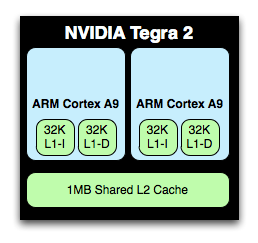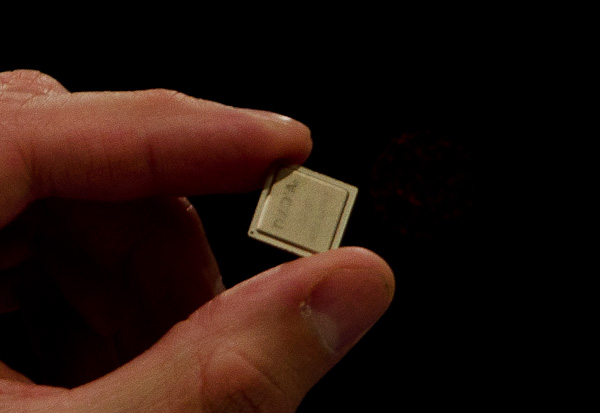NVIDIA's Project Kal-El: Quad-Core A9s Coming to Smartphones/Tablets This Year
by Anand Lal Shimpi on February 15, 2011 9:05 PM ESTThe Architecture
Kal-El looks a lot like NVIDIA's Tegra 2, just with more cores and some pin pointed redesigns. The architecture will first ship in a quad-core, 40nm version. These aren't NVIDIA designed CPU cores, but rather four ARM Cortex A9s running at some presently unannounced clock speed. I asked NVIDIA if both the tablet and smartphone versions of Kal-El will feature four cores. The plan is for that to be the case, at least initially. NVIDIA expects high end smartphones manufacturers to want to integrate four cores this year and going in to 2012.

The CPU cores themselves have changed a little bit. Today NVIDIA's Tegra 2 features two Cortex A9s behind a shared 1MB L2 cache. Kal-El will use four Cortex A9s behind the same shared 1MB L2 cache.
NVIDIA also chose not to implement ARM's Media Processing Engine (MPE) with NEON support in Tegra 2. It has since added in MPE to each of the cores in Kal-El. You may remember that MPE/NEON support is one of the primary differences between TI's OMAP 4 and NVIDIA's Tegra 2. As of Kal-El, it's no longer a difference.

Surprisingly enough, the memory controller is still a single 32-bit wide LPDDR2 controller. NVIDIA believes that even a pair of Cortex A9s can not fully saturate a single 32-bit LPDDR2 channel and anything wider is a waste of power at this point. NVIDIA also said that effective/usable memory bandwidth will nearly double with Kal-El vs. Tegra 2. Some of this doubling in bandwidth will come from faster LPDDR2 (perhaps up to 1066?) while the rest will come as a result of some changes NVIDIA made to the memory controller itself.
Power consumption is an important aspect of Kal-El and Kal-El is expected to require, given the same workload, no more power than Tegra 2. Whether it's two fully loaded cores or one fully loaded and one partially loaded core, NVIDIA believes there isn't a single example of a situation where equal work is being done and Kal-El isn't lower power than Tegra 2. Obviously if you tax all four cores you'll likely have worse battery life than with a dual-core Tegra 2 platform, but given equal work you should see battery life that's equal if not better than a Tegra 2 device of similar specs. Given that we're still talking about a 40nm chip, this is a pretty big claim. NVIDIA told me that some of the power savings in Kal-El are simply due to learnings it had in the design of Tegra 2, while some of it is due to some pretty significant architectural discoveries. I couldn't get any more information than that.

Kal-El vs. Tegra 2 running 3D game content today at 2 - 2.5x the frame rate
On the GPU side, Kal-El implements a larger/faster version of the ULP GeForce GPU used in Tegra 2. It's still not a unified shader architecture, but NVIDIA has upped the core count from 8 to 12. Note that in Tegra 2 the 8 cores refer to 4 vertex shaders and 4 pixel shaders. It's not clear how the 12 will be divided in Kal-El but it may not be an equal scaling to 6+6.
The GPU clock will also be increased, although it's unclear to what level.
The combination of the larger GPU and the four, larger A9 cores (MPE is not an insignificant impact on die area) results in an obviously larger SoC. NVIDIA measures the package of the AP30 (the smartphone version of Kal-El) at 14mm x 14mm. The die size is somewhere around 80mm^2, up from ~49mm^2 with Tegra 2.











76 Comments
View All Comments
Khato - Wednesday, February 16, 2011 - link
The only portion of the design that could be considered 'new' is the 1.5x GPU, but given NVIDIA's expertise in that area it's not too surprising that they'd have no issues executing that. The actual core changes consist of using another pre-made component, the MPE, per core and then doubling the number of cores... In other words, I'd be shocked if they got back first silicon and it -didn't- work flawlessly. That's kinda the point of licensing a design that's already fully tested and simply needs to be 'plugged in'.As for the performance metrics demonstrated... The 'gaming' is most likely due to the improved graphics, which is unquestionable NVIDIA's strength. The "Coremark 1.0" results meanwhile are yet more amusing. If that Kal-el score is indicative of final frequency performance, then I'd expect it to still be running at 1GHz because Coremark is an unrealistic benchmark that scales linearly with number of cores. It's also basically just an integer benchmark (more information is available on their site.) aka, that benchmark implies zero per-core performance increase for Kal-el over Tegra 2.
supergoodness - Wednesday, February 16, 2011 - link
Being a HUGE Superman fan I have newfound love for NVIDIA since all these processors are codenamed superheroes.Kal-El – Superman
Wayne – Batman
Logan – Wolverine
Stark – Ironman
I guess I am easily entertained :)
ssiu - Wednesday, February 16, 2011 - link
That is going to cause serious "Osborne effect" to all the Tegra2 tablets that are almost available now; if one can get something "5x better" in 6 months.sarge78 - Wednesday, February 16, 2011 - link
Looking forward to your analysis!rs2 - Wednesday, February 16, 2011 - link
So nVidia is claiming better performance than a Core 2 Duo, with power consumption that is suitable for a smartphone? I find that a little hard to believe. Both Intel and AMD are still at least a couple of iterations away from that mark with their current low-power offerings, so nVidia's claims seem a bit suspect, if you ask me.dagamer34 - Saturday, February 19, 2011 - link
The Core 2 Duo nVidia is comparing it's chip to is about 5 years old and was originally built on the 65nm process. Tegra 3 will be a 40nm process. Going from 65nm->40nm gives you about 2.56x number of transistors to work with. Also, the T7200 wasn't exactly the fastest that Intel had to offer at the time, but the Tegra 3 is bleeding edge.Bonesdad - Wednesday, February 16, 2011 - link
can they put Tony Stark above Bruce Wayne??? And Logan....really...T2k - Wednesday, February 16, 2011 - link
Seriously: other than shills like Anand etc does anyone else do this kinda of slave pieces like this?I mean full of BS PR, nothing concrete, only marketing shit for NV?
fr500 - Thursday, February 17, 2011 - link
We need a Zotac motherboard/nettop with this and a custom Android interface, use office live or whatever and you have a more than enough system for daily usage, multimedia and even casual gaming (and not so casual with gameloft ripoffs)tkafafi - Thursday, February 17, 2011 - link
I was planning on getting a tablet this year; but waiting to see the ipad 2 specs.Seeing how fast the soc chips are evolving is making me wonder whether I'd be better off waiting for next year. I guess that is always the case in gadget world :)
from the looks of it 2012 tablet features could include :
* quad core arm processors
* High resolution screens (ipad3 is rummored to be 4x this years model).
* LTE ? Xoom is already commited to LTE upgrade.
Hmmmm .... decisions decisions ....